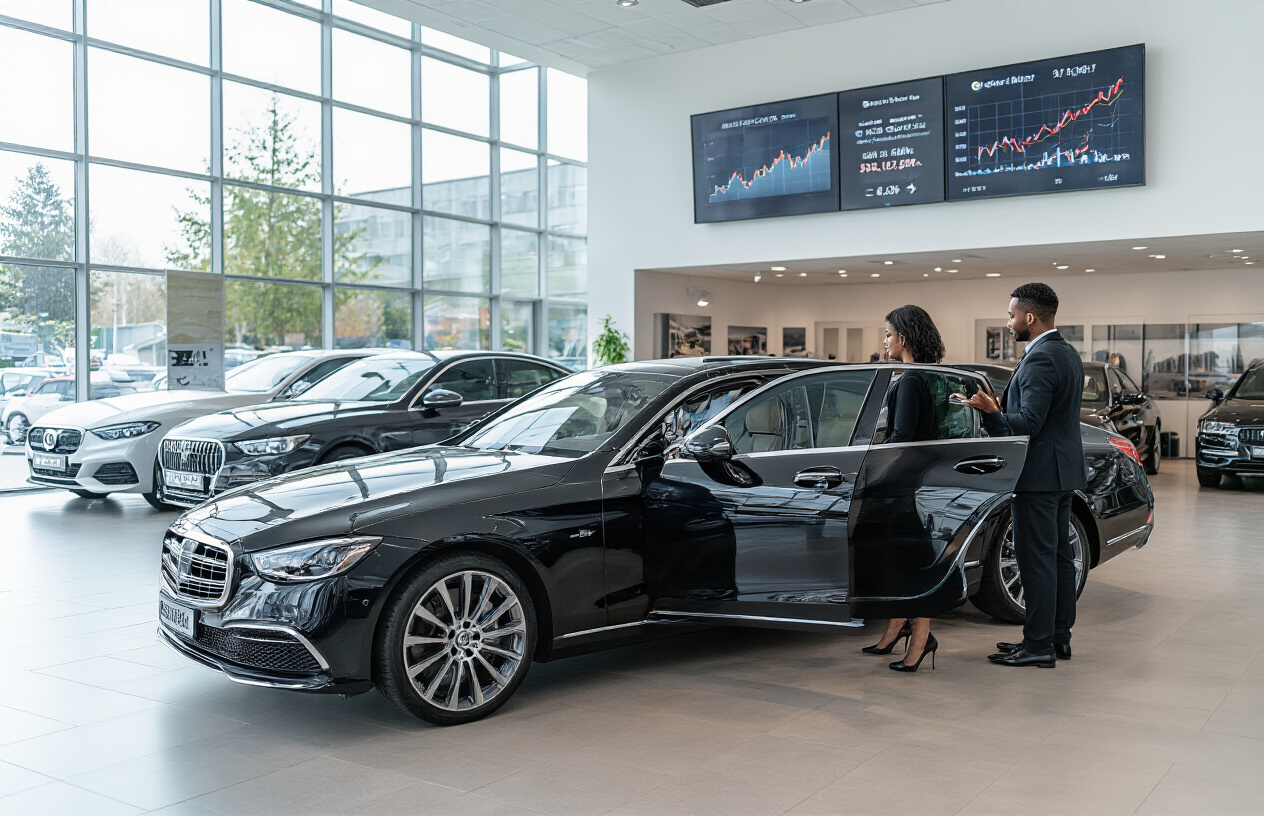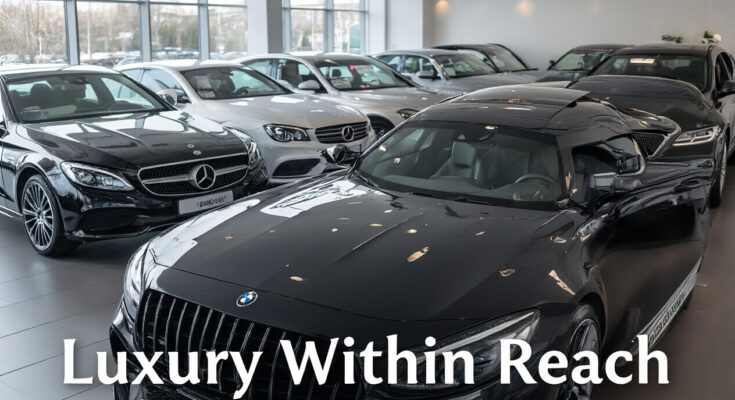Ever felt that mix of excitement and terror when dropping $80,000 on a luxury car? Now imagine getting that same car for half the price. That’s the magic of the second-hand luxury market that most folks miss out on.
I’m about to save you thousands on your next automotive indulgence while making sure you don’t end up with an expensive headache.
Finding the best deals on second-hand luxury cars in the USA isn’t about luck – it’s about knowing exactly where to look and which questions to ask before money changes hands.
The difference between driving home in a bargain BMW or overpaying for someone else’s problems often comes down to just five minutes of research. And you won’t believe what dealerships don’t want you to know about certified pre-owned programs.
Understanding the Luxury Car Market

Current trends in second-hand luxury vehicles
The luxury car market is going wild right now. Prices have been on a rollercoaster since 2020, with many models actually appreciating instead of depreciating. Crazy, right?
Post-pandemic, we’ve seen a shortage of new vehicles pushing buyers toward pre-owned options. This created a seller’s market where some barely-used luxury models were selling for more than their original sticker price. That bubble has started to deflate, making now a smart time to shop.
Electric luxury vehicles are gaining serious traction too. A 2-3 year old Tesla Model S or Porsche Taycan can save you 30-40% compared to new, while still packing cutting-edge tech and impressive range.
Top luxury brands with best resale value
Not all luxury badges hold their value equally. Some are practically investment pieces, while others drop faster than a stone.
Porsche consistently dominates the resale game. A 911 might cost you dearly upfront, but it’ll retain about 60% of its value after five years.
Mercedes-Benz and Lexus follow closely behind. The Lexus LS and Mercedes S-Class depreciate more gracefully than their competitors, making them smart buys on the pre-owned market.
Here’s how the top performers stack up:
| Brand | Average 5-Year Value Retention |
|---|---|
| Porsche | 58.2% |
| Lexus | 54.8% |
| Mercedes-Benz | 47.2% |
| BMW | 44.6% |
| Audi | 42.4% |
Why buying used luxury cars makes financial sense
Buying a new luxury car is probably one of the worst financial decisions you can make. These babies can lose 20-30% of their value the moment you drive off the lot.
Grab a 2-3 year old model instead, and someone else has already taken that massive depreciation hit. You’re getting essentially the same car for 30-40% less.
You’ll also score more car for your money. That $50K budget might get you a bare-bones new luxury compact, or a loaded 3-year-old midsize with all the bells and whistles.
Maintenance costs often aren’t much different between a new model and one that’s a few years old, especially if you find a certified pre-owned vehicle with a warranty extension.
Insurance premiums typically run lower on used luxury vehicles too, putting even more money back in your pocket every month.
Where to Find the Best Deals

A. Reputable luxury car dealerships
Looking for second-hand luxury without the first-owner price tag? Established luxury dealerships are gold mines. Places like Hendrick Automotive Group and Sonic Automotive maintain pristine pre-owned inventories from Mercedes to Maserati.
What makes these spots worth your time? They thoroughly inspect each vehicle before it hits the showroom floor. Most offer warranties that beat independent sellers by miles. And let’s be honest – there’s something reassuring about buying your pre-loved Porsche from a place with a proper service department and reputation to protect.
The downside? You’ll pay more than private sales. But that premium buys peace of mind and often includes certified vehicle histories, financing options, and trade-in opportunities.
B. Online marketplaces specializing in premium vehicles
The digital revolution changed how we shop for luxury cars. Sites like CarGurus, AutoTrader’s premium section, and Bring a Trailer have become treasure troves for high-end vehicle hunters.
These platforms let you filter searches down to the exact model, year, and features you want. Found a gorgeous 2018 BMW 7 Series in Chicago but live in Miami? No problem. These sites connect buyers and sellers nationwide.
The smart move? Use these platforms to research prices across different regions. You might discover that flying to Arizona for that Jaguar F-Type saves you thousands compared to buying locally.
C. Certified pre-owned programs worth considering
Not all CPO programs are created equal. The best ones offer the closest thing to buying new without the brutal depreciation hit.
Mercedes-Benz’s Star Certified program extends the factory warranty up to two additional years with unlimited mileage. Lexus offers a 161-point inspection plus complimentary maintenance. Porsche’s program? Maybe the most comprehensive, with a 2-year unlimited mileage warranty after the original expires.
These programs typically include:
- Comprehensive multi-point inspections
- Remaining factory warranty plus extensions
- 24/7 roadside assistance
- Vehicle history verification
- Special financing rates
D. Auction opportunities for rare models
Want something truly special? Luxury car auctions offer rare finds you’ll never see at dealerships.
Barrett-Jackson and RM Sotheby’s hold legendary auctions where everything from vintage Aston Martins to limited-production Ferraris cross the block. For the more tech-savvy, online platforms like Cars & Bids focus on modern enthusiast vehicles including luxury models.
The auction route requires homework. Research previous sales of similar models, understand auction fees (typically 5-10% on top of your winning bid), and set a hard maximum price before the adrenaline of bidding kicks in.
The payoff? You might score that perfect Bentley Continental GT for 20% below market value, or find a collector-grade vehicle that’ll actually appreciate over time.
Price Range Expectations

Entry-level luxury models under $30,000
Think you can’t afford luxury? Think again. The second-hand market is packed with gems under $30K.
Older BMW 3 Series models (2015-2018) typically range from $20,000-$28,000 depending on mileage and condition. These offer that coveted German engineering without breaking the bank.
Lexus IS sedans remain the reliability champions in this bracket. A 2016-2018 model with reasonable miles can be yours for $25,000-$29,000. They hold their value for good reason – they simply don’t quit.
Mercedes C-Class sedans from 2015-2017 hover around $22,000-$29,000. Yes, that prestigious three-pointed star can actually fit your budget.
The real steals? Acura TLX and Infiniti Q50 models. These often slip under the radar but deliver impressive luxury for $18,000-$26,000.
Mid-range options between $30,000-$60,000
This sweet spot is where the luxury game gets serious.
Recent BMW 5 Series (2018-2020) models land in this range, typically $40,000-$55,000 depending on trim and options. The same goes for Mercedes E-Class sedans.
Jaguar XF models around 2019-2020 often surprise shoppers at $35,000-$45,000 – less than their German counterparts with arguably more visual flair.
Porsche Cayenne SUVs from 2016-2018 can be found between $45,000-$58,000. That’s a lot of performance SUV for the money.
Audi A6 models from 2019-2020 hover around $42,000-$52,000, offering that perfect blend of tech and understated luxury.
High-end luxury vehicles over $60,000
Now we’re talking serious indulgence.
Nearly-new Range Rover Sport models (2020-2021) command $65,000-$85,000 but deliver presence nothing else can match.
Recent Porsche 911s (2018-2020) typically fetch $80,000-$110,000 depending on specification. They’re practically investments, with historically strong value retention.
Barely-used BMW 7 Series and Mercedes S-Class flagships from 2020-2021 range from $70,000-$90,000 – less than two-thirds their original sticker prices.
Maserati Levante SUVs often surprise at $65,000-$75,000 for 2019-2020 models. Italian exotic flair with a (relatively) reasonable price tag.
Factors that influence pricing
Mileage remains king. Every 10,000 miles over average (roughly 12,000/year) can knock 5-8% off values.
Maintenance history is non-negotiable. Complete dealer service records can add 10-15% to a luxury vehicle’s resale value.
Option packages matter enormously. A fully-loaded model might command 20% more than its base-trim sibling.
Color combinations significantly impact desirability. Think twice about that purple interior unless you’re keeping it forever.
Timing your purchase matters too. Convertibles dip in winter, while SUVs often cost less in summer.
Regional price variations across the USA
The luxury market isn’t uniform nationwide.
Southern California and South Florida boast the highest concentrations of luxury vehicles, often meaning more competitive prices. Expect 5-10% savings compared to less saturated markets.
Rust-belt states offer potential bargains on summer-driven vehicles, but require thorough inspection.
Texas surprisingly offers some of the best deals on European luxury models, averaging 7-12% below national averages.
All-wheel drive models command significant premiums in Northeastern and Midwestern states – sometimes 15-20% more than their rear-wheel counterparts.
Convertibles and sports cars sell for premium prices in coastal states but can be bargains in the Midwest.
Assessing Vehicle Condition and History

Essential Inspection Checklist for Luxury Vehicles
Buying a second-hand luxury car without a proper inspection? That’s like buying a Rolex from a guy in an alley without checking if it actually ticks.
Start with the exterior – look for paint inconsistencies, panel gaps, or misaligned doors. These aren’t just cosmetic issues; they might reveal previous accidents or poor repairs.
The interior tells you how the previous owner treated their baby. Worn leather on a low-mileage car? Red flag. Check all electronics too – those fancy massage seats and ambient lighting systems cost a fortune to fix.
Always test drive on various road types. Listen for unusual noises when turning, braking, or hitting bumps. Luxury cars should float over imperfections, not crash through them.
Pop the hood even if you’re not mechanically inclined. Look for:
- Fluid leaks
- Corrosion around battery terminals
- Belt condition
- Engine cleanliness (overly clean might hide leaks)
Understanding Maintenance Records
The difference between a bargain and a money pit often lives in these papers.
Complete service records from authorized dealers add serious value. For luxury vehicles, regular maintenance isn’t just oil changes – it’s computer updates, suspension calibrations, and specialized care.
Missing maintenance intervals? Calculate the cost of catching up. A $15,000 discount might disappear fast when you’re facing a $8,000 timing belt service and $3,000 brake job.
Key maintenance points to verify:
- Timing belt/chain service
- Transmission fluid changes
- Brake fluid flushes
- Air suspension maintenance
- Software updates
Decoding Vehicle History Reports
CarFax and AutoCheck are your friends, but they don’t tell the whole story.
Multiple owners within short periods? That’s rarely a good sign. Same goes for cars that bounced between states quickly.
The report might show “minor damage” but what does that mean for a precision-engineered luxury vehicle? Even small accidents can throw off calibrations and alignments that affect ride quality.
Look for:
- Title status (salvage/rebuilt titles slash resale value)
- Reported accidents (severity matters)
- Service records
- Recall information
- Mileage verification
Common Issues with Specific Luxury Brands
Each luxury brand has its Achilles’ heel:
Mercedes-Benz: Air suspension issues in older E and S-Class models. The AIRMATIC system feels amazing when working but costs thousands when it fails.
BMW: Electronic gremlins, especially in 7-Series. Their iDrive systems from 2002-2008 were particularly problematic. Cooling system failures are common in 5 and 7-Series models.
Audi: Timing chain tensioners in 2.0T engines. Oil consumption issues in A4/A6 models from certain years.
Jaguar/Land Rover: Electrical issues and air suspension failures. Beautiful vehicles that sometimes spend too much time at the dealer.
Porsche: Generally reliable but IMS bearing failures in 996/997 911s can be catastrophic. Always check if this has been addressed.
Financing and Insurance Considerations

Specialized loan options for pre-owned luxury cars
Buying a pre-owned Bentley doesn’t come with the same financing options as picking up a used Honda. The game is different with luxury cars.
Most major banks offer special loan products specifically for high-end vehicles. Chase, Bank of America, and Wells Fargo all have premium auto loan divisions with perks regular car buyers never see. Credit unions are surprisingly competitive here too – some offer rates that beat the big banks by 0.5-1%.
Another route? The certified pre-owned financing through luxury manufacturers. BMW Financial Services and Mercedes-Benz Financial frequently run special APRs as low as 1.99% on their certified pre-owned vehicles. That’s practically free money.
Interest rates and down payment requirements
The numbers hit differently with luxury cars.
Most lenders want 10-20% down on pre-owned luxury vehicles – higher than the 5-10% they might accept for mainstream cars. Why? Depreciation risk.
Interest rates typically range:
| Credit Score | Typical APR Range |
|---|---|
| 760+ | 3.2% – 4.5% |
| 700-759 | 4.5% – 6.0% |
| 660-699 | 6.0% – 9.0% |
| Below 660 | 9.0%+ |
Coming with a pre-approval from your bank gives you massive leverage at the dealership. They’ll scramble to beat it, and sometimes they actually can through their captive finance arms.
Insurance costs and premium factors
Insurance for that pre-owned Porsche? Brace yourself.
Luxury cars cost 30-50% more to insure than mainstream vehicles. A pre-owned BMW 7-Series might run $2,500-3,500 annually compared to $1,200 for a Toyota Camry.
What drives the premium?
- Repair costs (parts aren’t cheap)
- Vehicle value (higher replacement cost)
- Performance capabilities (higher risk profile)
- Theft rates (some luxury models are theft magnets)
Your driving record and credit score impact rates even more dramatically on luxury vehicles. A single ticket might bump premiums by 15-20%.
Extended warranty options worth the investment
Factory extended warranties for luxury brands cost more but cover more. An extended warranty on a pre-owned Audi might run $3,000-5,000 but could save you $10,000+ on a single major repair.
Third-party warranties exist too, at about 30-40% less than factory options. Companies like Carchex and CarShield offer decent coverage, but read the exclusions carefully.
The sweet spot? Certified pre-owned (CPO) vehicles. They include warranty extensions from the manufacturer, often adding 2-3 years of coverage. This built-in protection can save you thousands while providing factory-backed repairs.
Negotiation Strategies

Research-based price negotiation tactics
Ever walked into a dealership and felt completely unprepared? Don’t sweat it. The secret weapon for luxury car negotiations is data.
Before you even step foot on that lot, grab pricing data from Kelley Blue Book, Edmunds, and NADA. Print these out. Dealers hate when you come armed with actual numbers.
Know the dealer invoice price – what they paid – and the typical markup on your dream Porsche or Benz. Most dealers expect to knock 10-15% off the sticker price for luxury vehicles.
When negotiating, start at 15-20% below asking. Sound crazy? It’s not. Luxury cars, especially those sitting on lots for 60+ days, have negotiation room.
Drop this line: “I’ve researched similar models at three other dealerships. They’re offering X amount. Can you beat it?” Watch how quickly they reconsider their “best price.”
Best times of year to purchase
Timing is everything when hunting second-hand luxury deals.
December is gold – dealers scrambling to hit annual targets will slash prices. End-of-month visits (especially quarter-ends: March, June, September) catch salespeople desperate to hit quotas.
Rainy Mondays and Tuesdays? Perfect. Dealerships are ghost towns, and bored salespeople are more willing to negotiate.
Avoid weekends when competition is fierce and salespeople can afford to be picky.
Model-year transitions offer sweet spots too. When the new BMW 5 Series drops, last year’s models suddenly become “old news” – despite being practically identical.
Leveraging vehicle flaws to lower prices
That tiny scratch? It’s your ticket to savings.
Minor cosmetic flaws are negotiation gold mines. Most luxury buyers want perfection, so even small issues make cars harder to sell.
Document every flaw with your phone camera. Create a list ranking issues from “minor concern” to “requires immediate attention.” When negotiating, pull out your phone and scroll through images – this visual demonstration is powerful.
Point out maintenance costs too. That gorgeous Mercedes S-Class? Remind the dealer that replacing air suspension costs $4,000+ – use this to justify a lower price.
Ask for the vehicle history report yourself, don’t trust their copy. Multiple owners, accidents (even minor ones), or inconsistent service records? All leverage points for your negotiation arsenal.
After-Purchase Considerations

Maintenance costs and scheduling
Buying that second-hand Porsche or Bentley is just the beginning of your journey. Luxury cars demand premium care—there’s no way around it.
Most high-end vehicles need service every 5,000-10,000 miles, and these aren’t your average oil changes. A routine maintenance visit for a Mercedes S-Class can easily hit $1,500, while a Ferrari might set you back $3,000+ for the same basic service.
The smart move? Budget at least $2,500-5,000 annually for maintenance. And never, ever skip scheduled services! That “minor” postponed maintenance becomes the $10,000 problem next year.
Finding reliable specialty mechanics
Your neighborhood mechanic who’s great with your Honda? Probably not the right person for your Maserati.
Look for:
- Specialists certified in your specific brand
- Shops with factory diagnostic equipment
- Mechanics with verifiable luxury experience
- Independent shops with strong reviews from other luxury owners
Ask current owners in online forums about who they trust. The right mechanic relationship is worth its weight in gold when owning these vehicles.
Parts availability and pricing
That unique headlight assembly for your Aston Martin? It’s not sitting on a shelf at AutoZone.
Many luxury parts must be ordered directly from manufacturers or specialty suppliers, with wait times sometimes stretching weeks. And the costs can be shocking—a windshield for some high-end models exceeds $2,000, while suspension components can reach $5,000+.
Smart owners:
- Build relationships with parts suppliers
- Consider OEM alternatives when appropriate
- Join owner clubs for parts-sharing opportunities
Preserving resale value
The difference between meticulous ownership and average care can mean tens of thousands at resale time.
Preserve value by:
- Keeping comprehensive service records
- Storing your vehicle properly (climate-controlled if possible)
- Addressing small issues immediately before they become major
- Maintaining original components and avoiding questionable modifications
- Having paintwork professionally done when necessary
Your documentation matters almost as much as the car’s condition. Every service, repair and upgrade should be logged with receipts.

Navigating the luxury second-hand car market requires careful research and consideration. From understanding market trends to knowing where to find the best deals, being informed about price ranges, vehicle history, and financing options puts you in a stronger position. The right negotiation strategies can save you thousands, while proper after-purchase planning ensures your luxury vehicle remains a joy rather than a burden.
Remember that the perfect luxury car purchase balances your desires with practicality. Take your time, conduct thorough inspections, secure appropriate financing, and don’t rush the process. With patience and knowledge, you can drive away in a premium vehicle that delivers both prestige and value. Your dream luxury car is within reach—just ensure you’re making a smart investment rather than an impulsive purchase.




